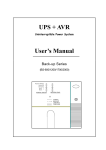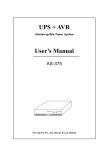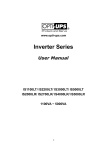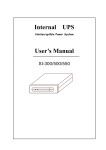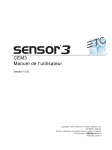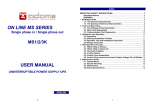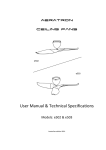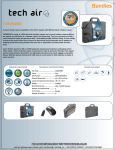Download UPS + AVR User's Manual
Transcript
UPS + AVR Uninterruptible Power System User’s Manual Sine Wave Line-Interactive (Model : 5000VA) 5% or 8% for AVR TABLE OF CONTENTS FRONT PANEL --------------------------------------------------------------- Page 3 REAR PANEL ----------------------------------------------------------------- Page 3 1. INTRODUCTION ----------------------------------------------------- Page 4 2. MAIN FEATURES ---------------------------------------------------- Page 5 3. CAUTION --------------------------------------------------------------- Page 5 4. INSTALLATION AND OPERATION ----------------------------- Page 6 – 9 5. INDICATION AND CONTROL ------------------------------------ Page 10 – 14 6. COMMUNICATION INTERFACE -------------------------------- Page 15 7. TROUBLE SHOOTING --------------------------------------------- Page 16 8. SPECIFICATIONS --------------------------------------------------- Page 17 9. IMPORTANT SAFETY INSTRUCTIONS ---------------------- Page 18 – 19 1 FRONT PANEL Tower Type Rack Mount Type Introduction of LCD display Load level • • Mode & value AC out V AC in Hr. to ON Min. to OFF BATT. SELECT Battery level 1 TEMP. POWER ON / OFF SELF TEST ALARM RESET • TIMER • • LOW HIGH 3 2 1 Main control button. 2 LCD screen. 3 Selection button for mode & value. 2 Rear Panel I. A. B2. B1. H. J. K. G. F. E. D. C. A. Inlet (screw type). B. Outlets B1. B2. B3. Universal sockets 2 x 2 + screw terminal x 1, or IEC 5 sockets x 3, or IEC 5 sockets x 2 + Germany type x 1 C. Re-settable fuses for output. D. Re-settable fuse for input. E. SNMP slot. F. Cooling fan. G. RJ-11 port. H. DIP switch. I. Communication port (RS-232). J. Handles. 3 B3. 1. INTRODUCTION 1.1 Overview: The series UPS is an advanced Line-Interactive Uninterruptible Power System which produces pure sine wave power to your equipment; unlike the traditional off-line UPS, the series provide very short transference when blackouts happen, and zero transference from AC mode to battery mode or from battery mode to AC mode. The voltage regulation performance of series is similar to an On-line UPS; however, the series provide efficiency over 98% under normal power condition. Two charge modes, quick charge and trickle charge, are provided to maintain the batteries in the best condition. 1.2 Battery replacement warning The self-test function (by pushing the button) will inform you with an alarm when the batteries are weak and require replacement. 1.3 DIP Switches DIP switches allow you to adjust the UPS for different line voltages and frequencies in different areas. It also allows you to enable the green power function to shut down the UPS automatically if the load is less than 25W, and then to extend the battery life. 1.4 Communication interface 3sets of communication ports (1set of RS-232/SNMP, and 2sets RS-232/DB-9) for sensing input voltage, output voltage, battery capacity, output power level, and UPS statuses are provided; through this port, you can remote control the UPS for turning on and off by customized schedule and setting the auto-test procedure. 1.5 Extra wide voltage of AVR The AVR range for the model is made as precise as ±5% for output with input range ±22% (or, upon request, ±8% for output with input range ± 35%). 1.6 Warning for failed battery (Real-time detection) The battery self-detect function will run every 20 minutes (no need to push the button by user). The “Battery replacement” symbol on LCD panel will show up when battery failed or is in open circuit. 4 2. MAIN FEATURES : Pure sine wave output. Zero Transference. Line-Interactive structure. Microprocessor based design. RS-232 interface for communication. ‘Green Power’ designed with auto on/off function. Protection for overload, short circuit, & over heat. 3. CAUTION: The UPS is designed to power computer loads and the associated peripheral devices, such as monitors, modems, external H-Disk drivers, etc. To ensure the performance of the UPS, Do Not load the UPS with motor, or any type of inductive load. Connecting the UPS to a two-pole, three-wire grounding mains receptacle. Connection with any other type of receptacle may result in a shock hazard and may violate local electrical codes. Do not allow water or any foreign object to get inside the UPS. do not put objects containing liquid on or near the unit. And Keep UPS away from fire or heating sources. The standard models are shipped from the factory with fully charged internal batteries; however, the batteries may lose some energy during delivery and storage. To ensure that the UPS will provide the expected run-time during a blackout, the UPS must be left in charging for at least 5 hours before your first use. The batteries are charged automatically by the UPS whenever the UPS is connected with city power (No need to turn on the UPS). 5 4. INSTALLATION13 & OPERATION: 4.1 Unpacking & Installation 4.1.1 Inspecting the packing carton for damage that may have occurred while in transit. Immediately notify the carrier and place of purchase if any damage is found. Retain the package for future use. 4.1.2 The packing of the UPS is separated into 3 units, main unit weight 39kgs, & 2 units of battery set weight 18kgs of each. Each battery set contains 6pcs of 12V battery. 4.1.3 To move the units, main unit needs 2-3 persons; while the battery set can be moved by one for each. 4.1.4 The UPS can be used as a rack-mount unit, or a tower one. Please follow the steps to make it as a rack-mount unit or a tower one as below: 4.1.4.1 Tower type --- To screw on the rubber pad (6pcs, as attached) at the bottom side of the unit; or put on 4 wheels (optional). Bottom side (with pads, or wheels) 4.1.4.2 Rack mount type --- to screw on the handling ears as a regular rack mount unit, put it on the rack, and fix it. Adjust the display panel between tower & rack mount types, you can make it easily simply by screwing on/off the 4 screws around the display panel with 90° turning on the panel. 6 4.1.5 To install the UPS, please fix the main unit first; then, put on the battery set one by one, and finish the connection (Ref. 4.2); finally make connection for input and output of the UPS. 4.1.6 To ensure that your computer or equipment will be protected during a utility failure, it is important to make sure that the maximum power needed by the equipment is not over the rated capacity of the UPS. The over load mark on LCD panel will be lighted up and alarm will beep if the load is over the rated value. Meantime, if the overload is severe, the UPS will shut down immediately for protecting UPS itself. 4.2 Battery Installation / Replacement 4.2.1 This is a hot-swappable designed UPS, which means that when you are replacing battery set, the UPS doesn’t need to be turned off. 4.2.2 To install or replace batteries, please screw off the 4 screws of front panel, disconnect the cable connection to the LCD display module; then please disconnect and pull out one of the two battery sets, and keep the other set in connection so that your equipment can be still protected during the period of time for battery replacement. (DWG. 4.2.2-1 (DWG. 4.2.2-2 Front view of the unit) Inside view when front panel is removed. 7 4.2.3 Please screw off the top cover of the battery set to be replaced, change the batteries inside with the same spec. & number, and make it in series connection. (DWG. 4.2.3 Inside view of battery pack when top cover is removed.) 4.2.4 Put back the battery set in the main unit, finish the connection with the UPS, and proceed the same steps for replacing the other battery set. 4.2.5 Once the battery replacement has been finished, please put back the cable connection to the LCD module, and tightly screw on the front panel. 4.2.6 The warranty will be void if to replace battery without the same spec or number. The battery type is 12V 7Ah, 6pcs for each pack, and 12pcs in total 4.3 Operation 4.3.1 After installation with normal city power, the UPS will charge the battery automatically, and the battery symbol and battery level will blink every second during charging. If AC auto turn-on function (Ref. 5.7) in enabled, the UPS will turn on automatically when city power is green. If auto turn on is disabled, please push the button about one second on the front panel, then the UPS will give power to the outlets after a short-time of self-test. 8 4.3.2 Pushing the button for 4 seconds, the UPS will turn off the power on the outlets. But, the UPS will keep charging if city power is normal. 4.3.3 During a blackout, push the button for entering idle mode (Ref. Indication Table of 5.3), then push again for one second, and the UPS will be turned on and enter into backup mode. To turn off the power from UPS; please push the button for 4 seconds, then UPS’s LCD screen will show OFF, wait for 5 seconds, and UPS will turn off the power automatically. 4.3.4 In idle mode, UPS will turn off the power automatically within 4 seconds during a utility failure; while UPS will keep charging the batteries if the utility power is normal. 4.4 “Green mode” setting: When “Green Power” function is enabled (Ref. to 5.7), the UPS will turn off the power within 30 seconds after blackout occurs with the power consumption lower than 25W. 4.5 Ring on function: When you are connecting the phone line through the UPS. The UPS may offer protection against damaging power fluctuations and surges that travel through the phone line. The UPS also offers a ring on function when the power is off. UPS power will be turned on automatically when a ringing signal exists in the phone line, and the UPS will keep power on until the UPS is turned off by button-pressing, or by the green power function or by RS-232 interface. 4.6 Enable/disable silence mode: The silence mode can be enabled or disabled only when the UPS is in back up mode or test mode. To push the test button for 0.5 second will enable/disable the silence mode. If UPS is in normal mode, UPS will run test mode once you push the test button, silence mode can be enabled/disabled during test mode. 9 5. INDICATION AND CONTROL 5.1 Indication LCD screen 5. 4. 15. 5 4 16 AC out 1. 2. 3. V AC in 2 BATT. Min. to OFF TEMP. Hz • TIMER 3 No. 1. Symbol 6 7 7. 8 8. 9 14. 14 15 LOW HIGH 6. 13. Hr. to ON LOW 9. 10 10. 1111.12 12. 13 Indication Over load Description The loading exceeds the rating of UPS. 2. Load level The higher the loading, the more bars will illuminate. 3. UPS is loaded 4. Normal mode When “Green Mode” is enabled, this symbol will display if the loading is over 30W (approximately), and disappears when it is under 25W (approximately). Refer to User’s Manual 4.3.5. If “Green Mode” is disabled, the symbol will always display. 1) The sine wave symbol will display steadily without battery symbol when UPS is in the normal mode. Battery mode 2) The sine wave symbol and battery symbol will blink when the UPS is in back-up (inverter) mode. Test mode 3) The sine wave symbol will display steadily with blinking battery symbol when the UPS is in testing mode. 10 No. 5. Indication Buck mode Description The AVR (Auto Voltage Regulator) is reducing the output voltage of the UPS (when the input voltage is too high), and the sine wave symbol, as mentioned in item 4, will also display steadily to indicate that the output is in the normal mode. 6. Boost mode The AVR is increasing the output voltage of the UPS (when the input voltage is too low), and the sine wave symbol, as mentioned in item 4, will display to indicate it’s in the normal mode 7. Timer is enabled 8. Symbol HIGH 9. 10. 11. 12. This symbol will show up in the following situations: 1) A turn-on / turn-off schedule has been set using the monitoring software. Refer to User’s Manual 5.5 and the “Readme” file or “Help” function of the monitoring software. 2) The Green Mode is enabled and the loading is under 25W (approximately). The UPS will turn itself off automatically in 30 seconds. Refer to 4.4 of User’s Manual. Thermal alarm The temperature inside the UPS is over 55•. If the user does not reduce the load, the temperature will continue to rise and the UPS will shut down automatically at 60•. Fan is in “High This symbol is used only for long back-up speed” models and 5000VA model. The symbol will display whenever the cooling fan is running in high speed, and will disappear at low speed. Silence mode The audible alarm has been silenced. To reset the alarm in Back-up mode, push the control button (not available during low battery level or abnormal condition). UPS fault The UPS has failed and must be repaired. Contact a qualified service person. Battery normal 1) In normal operation, this symbol indicates a charged battery. Battery low 2) LOW 11 When the battery charge level is low, the word “LOW” will be added to the symbol. No. 13. Symbol Indication Battery replacement 14. Battery voltage level 15. Mode Value Description The battery has failed and must be replaced. The battery is checked each time the Test Function is executed. 1) The higher the battery voltage, the more bars will illuminate. 2) When the UPS is charging the battery, the battery symbol and the level indicator will blink together. Description AC out V AC output voltage. AC in V AC input voltage. AC out Hz AC output frequency. BATT. V DC battery voltage. TEMP. TIMER • Min. to off UPS internal temperature. The UPS will turn off when the displayed value reaches zero. For example, if the timer shows 0.5 Min to off, the UPS will shut down in 30 seconds. TIMER Hr. to on The UPS will turn on when the displayed value reaches zero. For example, if the timer shows 48.0 Hr to on, the UPS will turn on in 2 days. BATT. Min. to off The estimated remaining run time in Back-up mode. The accuracy of the value is influenced by the loading type, ambient temperature and battery condition (old or new). Selection Button for mode & value. All the operation data will be displayed on LCD screen. By selecting the required mode (upward or downward), the related value will be displayed. 5.2 Control 5.2.1 Main control button: Please refer to point 4 & 5 (4.3 & 5.3-5.4). 5.2.2 Selection Button (with symbol of upward / downward): You may select a required mode, and the LCD will show you the value (Ref. Item 15 of LCD description). 12 5.3 Audible alarm During a utility failure or fault operation, the UPS emits beep for warning. In back-up mode, the beeping can be silenced by pushing the button. However, the warning of low battery will still sound for urging user to leave computer without any data loss. Basic Indication Table: STATUS Idle mode Utility Good No Beep Utility outage No Beep Timer on, (refer to Item 5.5) No Beep Normal Normal / (Utility good) Back-up mode Back-up (No load) Back-up (Loading) Abnormal Condition ALARM No Beep One beep every 4 sec (alarm can be silenced). 2 beeps every 4 sec. (alarm can be silenced). Battery Low 4 beeps per sec (alarm can Not be silenced). Battery NG. 8 beeps per sec (alarm auto stop after 8 seconds). Over load UPS fault Continuous alarm (alarm can Not be silenced). Every other 2 sec., 32 beeps in 2 sec (alarm can Not be silenced). Every other 2 sec., 32 beeps in 2 sec (alarm can Not be silenced). Thermal alarm 5.4 Auto self-test Function: In normal mode of UPS, turn on your equipment that connecting to the UPS and push the button on the front panel for self-test. The UPS will simulate a power outage and transfer your load to the UPS’s battery. If low battery warning sounds during the test, it means that the battery set is weak and requires extended recharge. If the warning of failed battery sounds, it means that the battery set is damaged and requires replacement. 13 5.5 Remote Control: The UPS can be set for daily shutdown/wake up. This command must be set through the RS-232 interface. When this function is set, the timer inside the UPS will begin to run, and the load will be turned off by the shutdown/wake up schedule. During the period of turn off to the next turn on, the LCD display will show “OFF”, to check the remaining time to the next turn on, please push the selection buttons, the LCD will show the remaining time in hours. 5.6 Reset the UPS If any abnormal condition occurs, and the item 4.3 can not be executed, please push the button for at least 10 sec. when all the LCD data disappear, then the UPS is reset. 5.7 DIP Switch Settings DIP Switch 1 2 3 4 DIP switch setting DIP 1 DIP 2 220V System 110V System Down Up 220V / 60Hz 100V / 50Hz Up Up 220V / 50Hz 110V / 60Hz Up Down 230V / 50Hz 115V / 60Hz Down Down 240V / 50Hz 120V / 60Hz DIP 3 for AC Auto turn-on when city power returns UP = Enable / Down = Disable DIP 4 for Green Mode setting UP = Enable / Down = Disable P.S.: Program setting active only after the UPS is re-started. 14 6. COMMUNICATION INTERFACE: The UPS provides both computer interfaces, smart software (RS-232) and dry contact (DB-9); by using different software and cable, the UPS shows different monitoring function. 6.1 The definition and setup for RS-232 is as following: Baud Rate : 2400 dps Data Length : 8 bits Stop Bit : 1 bit Parity : None 5 4 3 2 1 9 8 7 6 Pin #6 : RS-232 data Tx out. Pin #7 : Common of Pin #6 and Pin #9 Pin #9 : RS-232 data Rx In 6.2 The definition and setup for DB9 is as following: Pin #2 : AC Power Failure Pin #4 : Common GND of Pin #2 & Pin #5 Pin #5 : UPS Battery Low Pin #6 : Turn off UPS Pin #7 : GND of Pin6 The interface with computer is diagramed as above for your reference. Use Pin #4 as the common of Pin #2 and Pin #5, Pin #2 and Pin #4 will become close loop from open when the utility fails, Pin #5 and Pin #4 will become close loop from open when the battery level is low. The UPS will shut down itself when the high level from RS-232, sustained for 3 seconds, which is applied between Pin #6 and Pin #7. 15 7. TROUBLE SHOOTING Problem Possible Cause UPS no reaction while AC 1. Line cord plug is loose is connected 2. Fuse on rear panel blown (Inside the drawer of inlet) 3. Dead wall socket Action to Take 1. Check the line cord plug 2. Replace fuse 3. Check wall socket with a table lamp. Power output is normal, UPS UPS is over loaded emits continuous beep, LCD shows “Overload”. Turn off UPS and unplug excessive loads from UPS. No power on outlets, UPS UPS has shut down due to emits continuous beep, LCD overload. shows “Overload”. Unplug excessive loads from UPS, press button to reset the buzzer, and turn on the UPS again. UPS does not provide expected run time 1. Excessive loads connected at UPS’s outlets. 2. Battery is weak and can not provide enough capacity. Do not operate the UPS, and leave the UPS plugged in for 10 hours. Then, test it again, if UPS still can not provide expected run time, battery should be replaced. Button on front panel doesn’t work 1. The CPU inside UPS is not running correctly. 2. Button damaged. 1.Push the button for 10 seconds to reset the UPS. 2. Unplug line cord and all loads from the UPS to let it shut down automatically, and call for service. To push button for testing under AC mode, UPS emits urgent beep (8 beeps per sec.), and LCD shows “Battery replacement”. Battery is weak and should be Replace batteries. replaced UPS can not be turned on. 1. Battery polarity wrong 2. UPS fault 16 1. Check battery connection. 2. Call for service. 8. SPECIFICATIONS: CAPACITY INPUT OUTPUT 5000VA / 3500W Voltage Selectable 200/220/230/240V 1ø Frequency 50Hz/60Hz Auto detect Current (220V) 25A Voltage Rated voltage ±3% for Back-up Mode, or • ±5% for AVR (or• ±8% optional) Frequency 50Hz or 60Hz ± 0.1Hz (Selectable under DC start) Wave Form Pure Sine Wave Current (220V) 22.7A TRANSFER TIME Blackout 3.5 ms typical or Brownout < 1ms BATTERY Lead-Acid, maintenance free 12V 7Ah 12pcs YES Within 2 hrs LCD (symbol shown up) Alarm Sine Wave No beep Sine Wave+ Battery B-B-----B-B----- (2 beeps/4sec.) Sine Wave+ Battery B-B-----B-B----- (2 beeps/4sec.) (Transfer to backup mode) Sine Wave+ Battery B-B-----B-B----- (2beeps/4sec.) (Transfer to backup mode) Sine Wave No beep + Buck or (AVR in operation) + Boost B-B-B-B-B-B-------- (4 beeps/sec.) Sine Wave+ LOW+ Battery Battery replacement BBBBBBBB (8 beeps/sec.) Over load B……….. (continuously) High Temp. G . R . TYPE Battery quantity Level Ind. Recharge Time (to 90%) OPERATION INDICATION Normal city power Back up Mode Abnormal Freq. of City power (Freq. > 65Hz or < 47Hz) Abnormal V. of City power (Voltage > 122% or< 80%) Abnormal V. of City power (Voltage<122% but>105%or >80% but <95%) Low Battery Alarm Battery Fail Alarm Over load Alarm Thermal Alarm (G = 32beeps/2sec. R = silence / 2sec.) Safety Approval Remaining Backup Time DC Start / Alarm Reset Communication Interface Environment Temp. Environment Humidity Dimensions (H x D) Shipping Dimensions CE YES YES RS-232*1 0 - 40 30-95% Non-Condensing 4u x 52cm Separate packing carton for main unit (64x60x40cm) & battery packs (45x18x13cm) * 2sets; and, about 6 -10 sets per pallet. Weight (N.W. / G.W. Kg) 70 / 74 • Specifications subject to change without prior notice. 17 9. IMPORTANT SAFETY INSTRUCTIONS • When replacing the batteries, use the same number and the same type of batteries. • Do not dispose of batteries in a fire; the battery may explode. • Do not open or mutilate the battery or batteries, released electrolyte is harmful to the skin and eyes. • A battery can present a risk of electric shock and high short circuit current. The following precaution should be observed when working on batteries. * Remove watches, rings or other metal objects. * Use tools with insulated handles. • To prevent an overbalance of this unit, with the installation the additional stabilizer are to mount at the bottom side. • This unit should be installed from service personnel. • The equipment can be operated by any individuals with no previous experience. • “The socket-outlet shall be installed near the equipment and easily accessible.” • “With the installation of this equipment it should be prevented, that the sum of the leakage current of the UPS an the connected consumer does not exceed 3.5mA.” • Attention, hazardous through electric shock. Also with disconnection of this unit from the main, hazardous voltage still may be accessible through supply from battery. • The battery supply should be therefore disconnected in the plus and minus pole through the from the outer enclosure accessible battery fuses when maintenance or service work inside the UPS is considered. • The lead acid battery may cause chemical hazard. • The battery presents a risk of electric shock and energy hazard. • Batteries will be disposed by the manufacturer or importer. Customers need to send them back with no charge for disposal. • Electrical hazard, the discharge time is about 5 min. 18 German wording: • • • • • • • Wenn Sie die Batterien austauschen, verwenden Sie bitte die gleiche Anzahl und den gleichen Batterietyp. Werfen Sie niemals die Batterien in das Feuer, die Batterien könnten explodieren. Öffnen oder beschädigen Sie nicht die Batterien, ausfileβendes Elektrolyt ist schädlich für Haut und Augen. Eine Batterie kann eine Gefahz eines elektrischer Schlages und sehr groβer Kurzschluβströme beinhalten. Folgenda Vorkehrungen soiiten getroffen warden, wenn Sie mit der Battery arbeiten. * Entfernen Sie Uhren, Ring and andere metallische Objekte. * Verwenden Sie Werkzeug mit isolierten Griffen. Um ein Umkippen dieses Gerätes zu verhindern, sind mit der Installation dieses Gerätes die zugätalichen Stützen an der Unterseite dieses Gerätes anzubringen. Dieses Gerät ist durch Elektrofachkräfte zu installieren. Bedienung durch jedermann ohne dem Vorkenntnisse. • “Die Steckdose muβ nahe dem Gerät angebracht und leicht zugänglich sein.” • “Bei der Installation dieses Gerätes ist darauf zu achten, daβ die Summe der Ableitstöme der USV und der angeschlossenen Verbraucher den Maximalwert von 3.5mA nicht Überschreiten.” “Vorsicht, Gefahr durch elektrischen Schlag. Auch nach Trennung von der Netzeingangsspannung werde Teile innerhalb der USV von der Batterie gespeist und führen gefährliche Spannung. Bei Instandhaltungsarbeiten ist daher die Versorgung durch die Batterie an den von auβen zugänglichen Sicherungshaltern in beiden Polen zu unterbrechen.” Die Blei-Akkumulatoren Können bei unsachgemäβer Handhabung chemische Gefahren hervorrufen. Die Batterie birgt eine Gefahr eines elektrischen Schlages und sehr hoher Kurzschluβstroeme. Batterien werden durch den Hersteller oder Importeur entsorgt. Dazu muessen die Batterien kostenfrei angeliefert werden. Gegahr durch elektrischen Schlag, die Entladeit dieser Kondensatoren beträgt 5 min. • • • • • • 19






















